ISSN: 1204-5357
ISSN: 1204-5357
| CHAI-LEE GOI, PhD Senior Lecturer, Department of Marketing and Management, School of Business, Curtin University, Sarawak, Malaysia Postal Address: CDT 250, 98009 Miri, Sarawak, Malaysia Author's Personal/Organizational Website: http://www.curtin.edu.my |
| Dr. Chai-Lee Goi is a senior lecturer at Department of Marketing and Management, Faculty of Business and Humanities, Curtin University, Sarawak Campus, Malaysia. His areas of interest are Internet marketing and Marketing. |
Visit for more related articles at Journal of Internet Banking and Commerce
From 1984 to 2010, there has been significant research related to E-banking which is encompassed various disciplines, marketing, E-commerce, IS, business and management. Most of these researches are related to the adoption and the use of Ebanking channels (Hoehle et al, 2012). This shows that the importance of E-banking currently. The main objective this paper is to review the E-banking in Malaysia. In addition, this paper also discusses the opportunities and challenges in the new era faced by financial institutions, especially commercial banks in Malaysia. To achieve sustainable financial institutions in Malaysia, it is important to identify the opportunities and challenges in the new era.
Keywords |
| E-banking; Financial institutions; Opportunities in the new era; Challenges in the new era; Malaysia |
INTRODUCTION |
| Since 1984, there has been significant research related to E-banking especially related to the adoption and the use of E-banking channels. Overall, all research related to Ebanking encompasses various disciplines of marketing, E-commerce, IS, business and management (Hoehle et al, 2012). Even, a review conducted by Hoehle et al (2012) shows that 247 studies related to E-commerce has been done between 1984 and 2010. The total output can be referred to Table 1. This shows the importance of research and development on E-banking. |
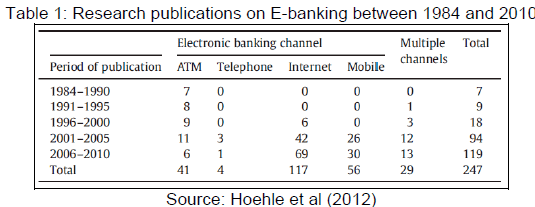 |
| “E-banking is defined as the automated delivery of new and traditional banking products and services directly to customers through electronic, interactive communication channels. E-banking includes the systems that enable financial institution customers, individuals or businesses, to access accounts, transact business, or obtain information on financial products and services through a public or private network, including the Internet” (The Federal Financial Institutions Examination Council, n.d). According to Nsouli and Schaechter (2002), E-banking is part of E-finance services (see Figure 1). |
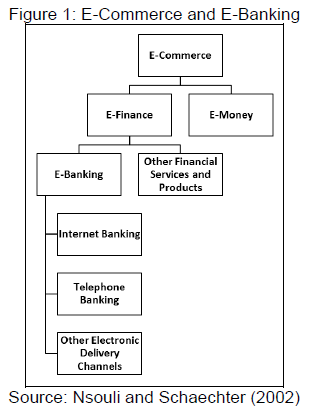 |
| The financial institutions must do far more to build sustainability into new strategies (Cowe, 2012). “The innovations of sustainability pioneers in the banking industry show companies addressing the key challenges of the industry through explicit programs aimed at embedding sustainability into every aspect of business, including supply chains, product design and innovation, marketing strategies and stakeholder relationships” (Accenture, 2011). |
FINANCIAL INSTITUTIONS AND E-BANKING IN MALAYSIA |
| On 29 July 1999, Bank Negara Malaysia announced the consolidation of 54 financial institutions under six anchored banks namely Maybank, Bumiputra Commerce Bank, Public Bank, Perwira Affin Bank, Multi-Purpose Bank and Southern Bank (Bank Negara Malaysia, 1998) with each group having a commercial bank, merchant bank and finance company (Bank Negara Malaysia, 1999). |
| On 14 February 2000, Bank Negara Malaysia announced on the approval has been granted for the formation of 10 banking groups. Tan Sri Dato’ Seri Ali Abul Hassan bin Sulaiman, the Governor of Bank Negara Malaysia (BNM) announced that Bank Negara Malaysia had studied carefully the merger proposals, which was submitted by the domestic banking institutions (Bank Negara Malaysia, 2000): |
| • Substantial reduction in the number of domestic banking institutions (54 institutions). |
| • The structure the mergers will reap the maximum synergy from the merger to improve the profitability and efficiency. |
| • Minimal disruption in the provision of banking services. |
| • Minimise post-integration costs. |
| • Sufficient size of each banking group. Each banking group will attain minimum shareholders’ funds of RM2 billion and asset base of at least RM25 billion. |
| Effective June 1, 2000, domestic banking institutions in Malaysia were allowed to provide Internet banking services to their customers, mainly related to informative, communicative and transactive services. Overall, E-banking services provided by financial institutions related to telephone banking, desktop banking, mobile banking and home banking (Bank Negara Malaysia, n.d1). Maybank launches Maybank2u.com in June 2000, making it the first bank in Malaysia to introduce Internet banking services (Maybank, n.d). Overall, all of the local commercial banks offering internet banking services and almost all banks offer mobile banking. However, only Alliance Bank, AmBank, CIMB Bank and Maybank at the moment are offering E-Money services (see Figure 2) (Bank Negara Malaysia, n.d2). |
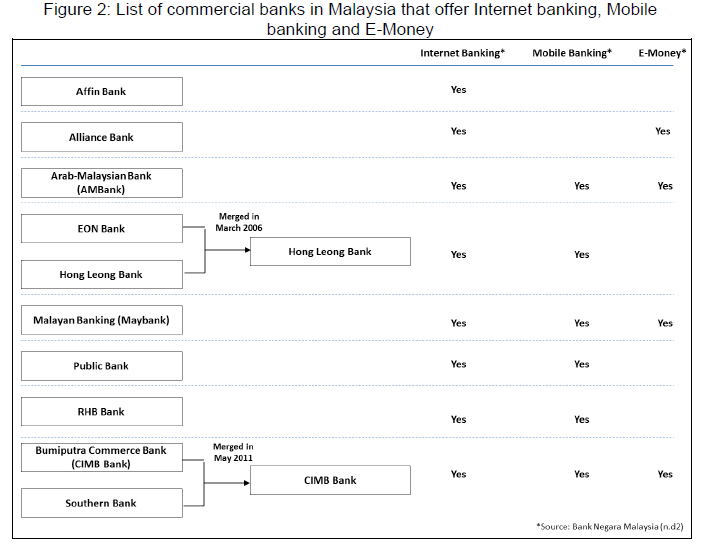 |
| There are nine focus areas under the financial sector blueprint to further advance financial sector development to drive Malaysia's transition to a high value-added, highincome economy with adequate safeguards to preserve financial stability. One of the areas is related to E-payments for greater economic efficiency. “In the next ten years, the Bank targets to increase the number of e-payment transactions per capita from 44 transactions to 200 transactions, and reduce cheques by more than half from 207 million to 100 million per year. Measures to achieve this aim will include providing the right price signals to encourage the switch from paper-based payments to e-payments, and facilitating wider outreach of e-payments infrastructure, such as point-of-sale terminals and mobile phone banking” (Bank Negara Malaysia, 2012). |
| As mentioned by Deputy Finance Minister Datuk Ahmad Maslan, Internet banking in Malaysia has grown significantly alongside the use of smart phones and tablets. As at June 2013, there were 14.6 million subscribers of Internet banking in Malaysia. This gives a 49.1% rate of penetration. For mobile banking, the number of subscribers has reached 3.25 million, with the penetration rate at 10.9% of the population and 7.6% of all mobile subscribers. Finally, in terms of growth, Internet banking has the potential to generate savings of about 1% of gross domestic product annually (The Star, 2013). |
OPPORTUNITIES IN THE NEW ERA |
| The adoption of digital and self-service channels in Asia, including Malaysia shows that financial institutions are focusing on adapting services to meet the demands of techsavvy consumers. Even, a survey shows that 50% of the respondents wanted a better functionality over the mobile banking channels, with percentage increasing to 70% for improvements of functionality of the Internet banking (Kumar, 2014). |
| There is a strong relationship between online channels for communication, customers’ satisfaction and customers’ loyalty, as well as retention. Banks need to make the paradigm shift in their management practices by continuous innovation in the service of customers. Banks need to change the way they interact with their customers and put attention on relationship and communication (Kirakosyan and DÃâÃÆnÃâÃÆiaÃâ¦Ã£ÃâÃÆ, 2014). |
| Even, there is an opportunity for the management to achieve customer relationship management using media, especially social media and website. “Social media is a large source and an important tool for communication. It has a big impact on today business world. Thus, E-banking management needs to identify ways to make profitable use of social media. Digital world plays an important role. By developing presence in digital world banks will be closer to customers. An attractive way of communication is a website. Besides content, interface, easy usage, convenience a good website need to give links to other needed information and sources. It should be easily identified and available to the users. Banks need to provide a good access speed and response on time” (Kirakosyan and DÃâÃÆnÃâÃÆiaÃâ¦Ã£ÃâÃÆ, 2014). |
| Yoon and Steege (2013) found that personality and perception of customers will significantly influence the use of Internet banking. The use of Internet banking is incorporated with openness toward advanced technology, Web site usability, perceived security concern, and also green concern for conserving nature resources as the social influences. |
| Others studies done by Akinci et al. (2004) and Hanafizadeh et al. (2014) shows the positioning of Internet banking adoption within the border of Internet banking. They have identified four areas, which are interrelated with Internet banking. This includes banking services, distribution channels, bank and bank managers’ perspectives, and finally customers’ perspectives. |
| Based on the Global Retail Banking Report prepared by Jones Lang LaSalle (2012), commercial banks need to make further technology investments especially related to mobile banking. Several ideas have been suggested in this report as specified in the Table 2. |
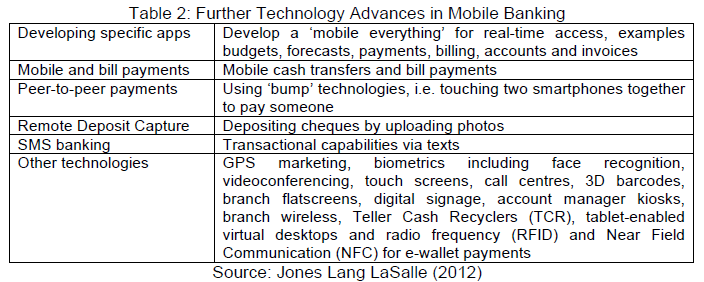 |
CHALLENGES IN THE NEW ERA |
| Given the dramatic changes in the financial industry, the traditional financial institutions are now even finding themselves in a situation where they have to work harder to keep their customers. Both internal and external factors have led to significant changes in the financial institutions. (see Figure 3) (Ibbotson and Moran, 2003). |
| As mentioned by Havasi et al (2013), E-banking provides enormous benefits to consumers in terms of the ease and cost of transactions, however, it also poses new challenges for country authorities in regulating and supervising the financial system and in designing and implementing macroeconomic policy. Even, there are number of new challenges, which are related to security concern; quality of delivery service, including delivery speed and delivery reliability; limited online payment options; and the issue of customer unfamiliarity with the internet. Number of researches has been found related to challenges of E-banking. |
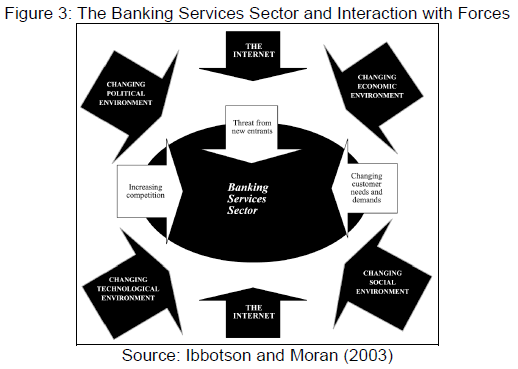 |
| Nsouli and Schaechter (2002) discussed the new challenges for country authorities in regulating and supervising the financial system and in designing and implementing macroeconomic policy. In terms of challenges for regulators, the major aspects are related to regulatory risk, legal risk, operational risk and reputational risk. As the advent of E-banking quickly changes the financial landscape and increases the potential for quick cross-border capital movements, macroeconomic policymakers face several challenges. There are 5 questions that are emphasised in relation to microeconomic challenges. |
| All these questions can be referred below as adopted from an article written by Nsouli and Schaechter (2002). |
| 1. “If electronic banking does make national boundaries irrelevant by facilitating capital movements, what does this imply for macroeconomic management? |
| 2. How is monetary policy affected when, for example, the use of electronic means makes it easier for banks to avoid reserve requirements, or when business can be conducted in foreign currencies as easily as in domestic currency? |
| 3. When offshore banking and capital flight are potentially only a few mouse clicks away, does a government have any leeway for independent monetary or fiscal policy? |
| 4. How will the choice of the exchange rate regime be affected, and how will e-banking influence the targeted level of international reserves of a central bank? |
| 5. Can a government afford to make any mistakes? Will the spread of electronic banking impose harsh market discipline on governments as well as on businesses?” |
| Furthermore, Nsouli and Schaechter (2002) suggested two emerging strands of thought related to these problems. Firstly, the technological revolution, particularly the expansion of E-money and electronic advances in banking practices could result in a decoupling of households’ and firms’ decisions from the purely financial operations of the central bank. Secondly, as E-banking expands, financial transaction costs can decline significantly. |
| Jung et al. (2001) and Ifinedo (2009) discussed that financial institutions face four main threats to organisational IT data and assets, which are related to interception, interruption, modification, and fabrication. The major reasons financial institutions wary of breaches and threats relative to other businesses are over-reliance on ICT use in their operations; losses emanating from breaches in their operations can be extremely large; and the need to maintain a good public image and assure the confidentiality and integrity of their data and ICT assets (Goodhue and Straub, 1991; Ifinedo, 2009). |
| A study done by Gikandi and Bloor (2010) shows that various future challenges identified in the current study included Internet security, customer and legal related issues besides technical issues (see Table 3). |
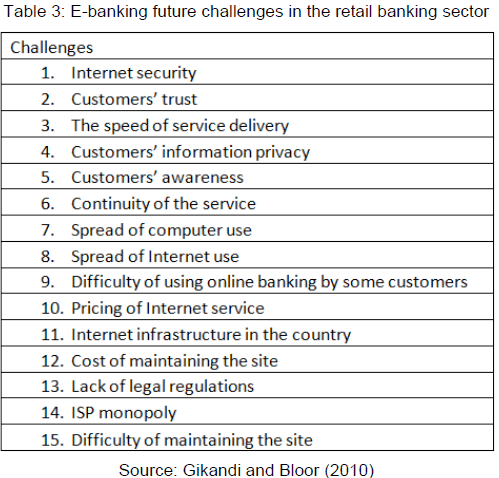 |
| Another research done by Martins et al (2014) reveals that perceived risk is an important factor affecting end-user intention to use Internet banking. The management needs to consider good safety practices. The problems associated with the security of E-banking include computer crime, invasion of privacy, a transaction without any errors and the management needs to allocate sufficient resources to correct it if there is a problem occurs. |
| Sakalauskas et al (2009) stated that the sustainability of the E-banking is closely associated to environmental, social and governance. In addition, the development of Ebanking towards sustainability also includes 12 features as listed in the Table 4. |
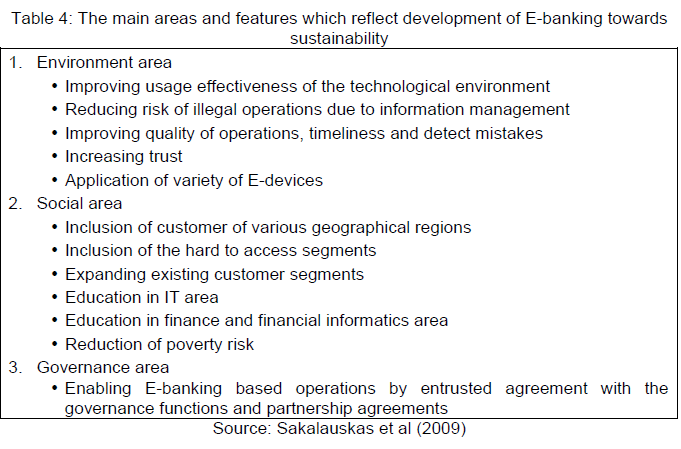 |
CONCLUSION |
| There is a great opportunity for commercial banks in Malaysia to adopt Electronic banking. As mentioned by Kirakosyan and DÃâÃÆnÃâÃÆiaÃâ¦Ã£ÃâÃÆ (2014), the commercial banks need to make the paradigm shift in their management practices by continuous innovation in the service of customers, especially in terms of relationship and communication. Even, Cowe (2012) highlighted that commercial banks must also do far more to build sustainability into new strategies. However, there are number of challenges, examples environmental, social, governance (Sakalauskas et al, 2009) and future challenges (Gikandi and Bloor, 2010), plus the rise of customer power needs to be faced in the new era. |
References |
|
Copyright © 2025 Research and Reviews, All Rights Reserved